Exercises to Correct Violating the Bent Knee Portion of the Definition of Race Walking

The Isometric Knee exercise is a mild strength training exercise that requires no extra weight and minimal movement of your body. It’s isometric (using tension without contraction) and trains your muscle memory to know what it feels like to straighten the knee.
Body Position
Sit down with your legs extended and a towel wrapped under your knees (Figure 5-26).
Steps
- Press down on the towel, straightening your knee (Figure 5-27). This causes your heels to lift off the ground.
- Hold for 3 seconds.
- Relax for 3 seconds. This causes your heels to return to the ground (Figure 5-26).
- Repeat 10-15 times. This can be done one leg at a time or with both legs simultaneously.
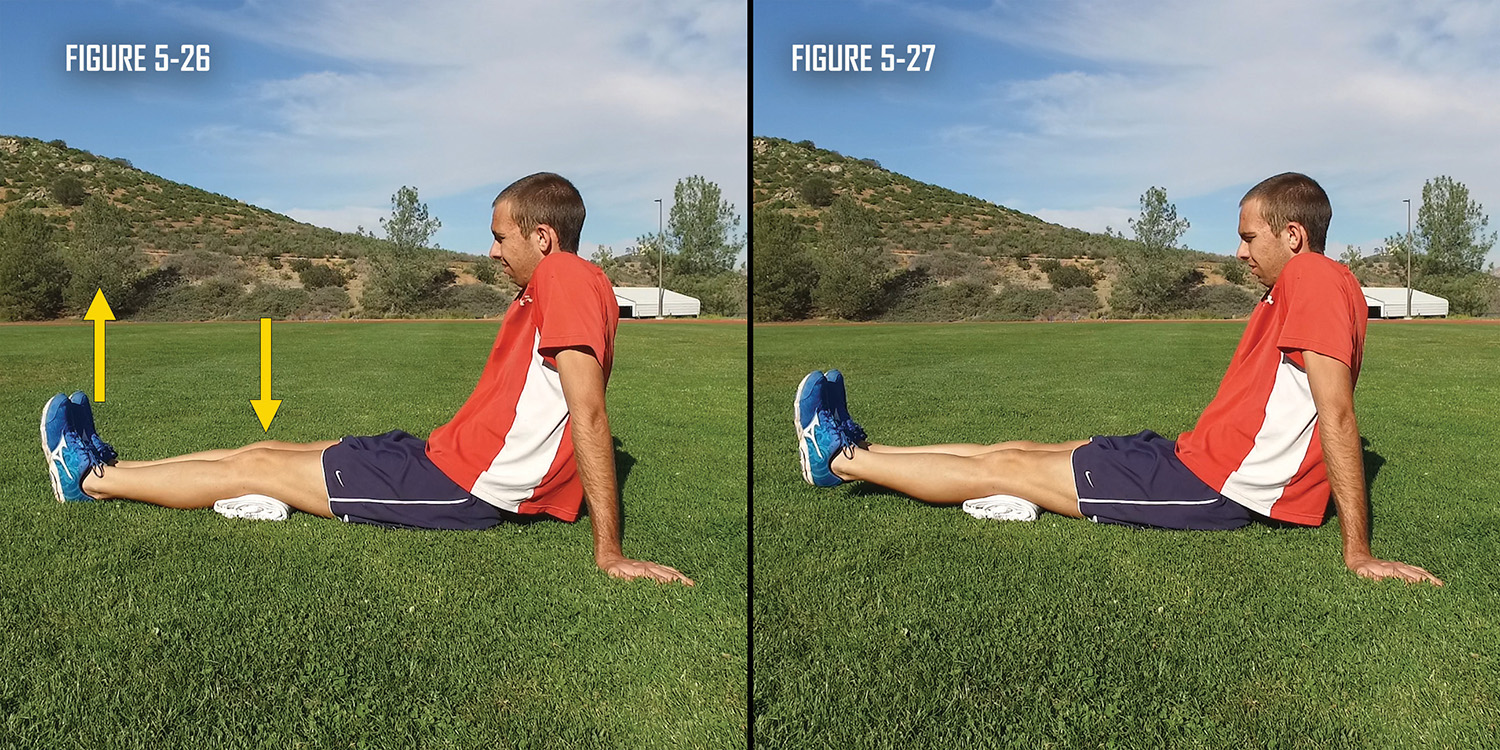

Like the isometric exercise shown earlier, this Straight Leg Raise exercise strengthens the quadriceps, but it also strengthens the hip flexors and abdominals. Since it strengthens your leg while keeping it straightened, it helps to promote muscle memory that enables you to walk without bending your knees at the incorrect time.
Body Position
This exercise can be done with or without a light ankle weight. It’s best to start without weight and gradually add light weights, building up to but never exceeding 10 percent of your body weight.
Lay on your back and support your body by bending one leg (Figure 5-28).
Steps
- Slowly raise the other straightened leg to about 45 degrees (Figure 5-29); hold it there for a second, and then gradually lower it.
- Repeat this exercise 15 times with one leg, then switch and repeat with the other leg.
- Perform 3 sets.
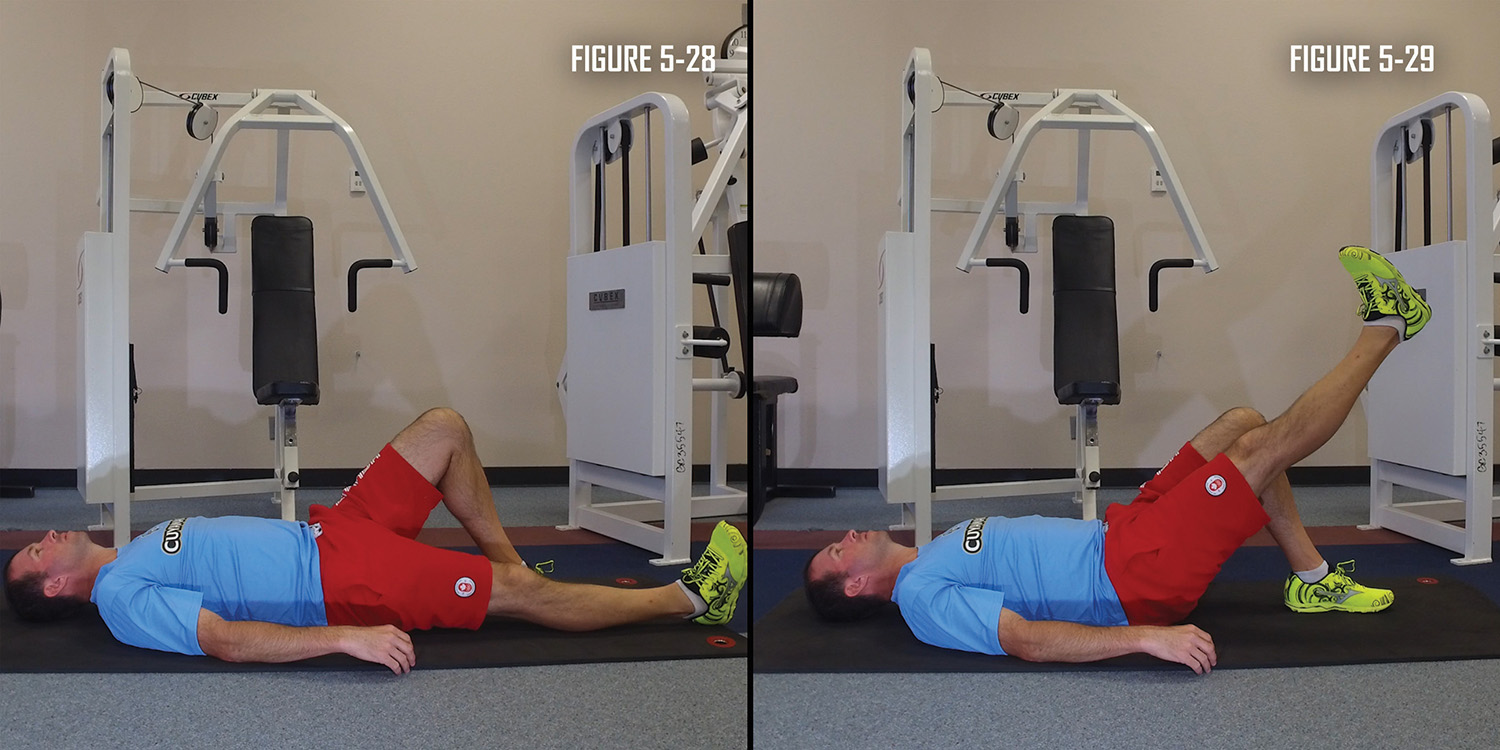

Writing an imaginary alphabet with your foot can strengthen and stretch the minor muscles around the ankle and can really help with your heel plant, roll through, and push off. When your lower leg muscles aren’t strong enough, either you will land flatfooted or your foot will flatten very quickly. If your foot is flat on the ground while it is still in front of your torso, your risk of a bent knee call is high.
Body Position
Sit down in a chair with one leg placed over the other.
Steps
- Slowly spell each capital letter of the alphabet with your toe (Figures 5-30 & 5-31).
- Repeat with the other leg / foot.
If you have a light ankle weight, you can place it around your foot and add extra resistance. This resistance could also be accomplished using an elastic band.
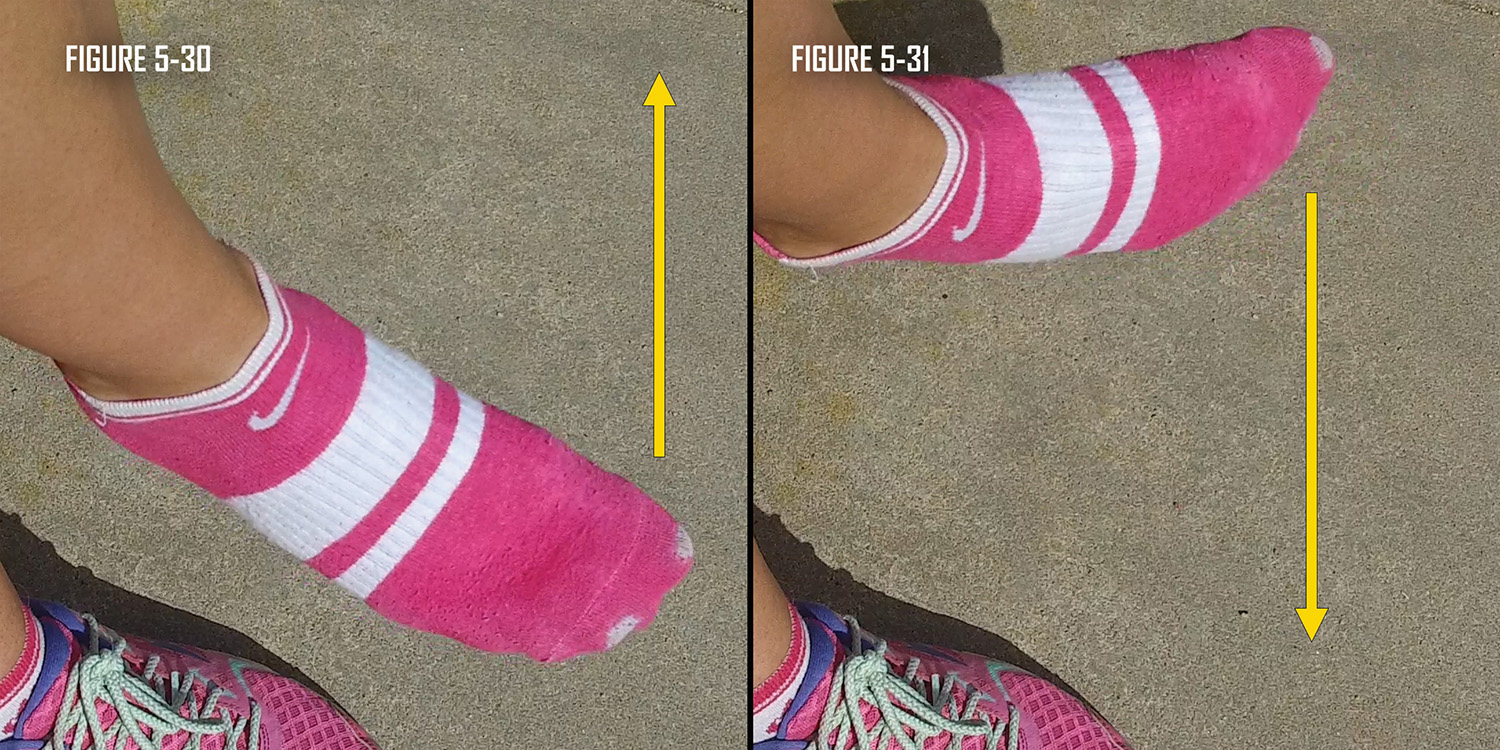

The old adage of “take baby steps” is also true for race walking drills. Walking slowly with an exaggerated heel plant is a superb way to practice landing with a straightened knee without the pressure of going fast. This drill also allows you to develop the feel for proper foot roll.
Body Position
Perform this drill using legal race walking technique.
Steps
- Start by taking a short step, emphasizing the toe up and straightened knee (Figure 5-32).
- Roll through the stride, keeping the supporting foot’s toes off the ground as long as possible.
- Pick the foot up (Figure 5-33) and place the swing leg’s foot down directly in front of the body (Figure 5-34), again emphasizing the toe up and straightened knee.
- Repeat for 30 meters.
While performing this drill, you will feel all the small muscles of your foot working.
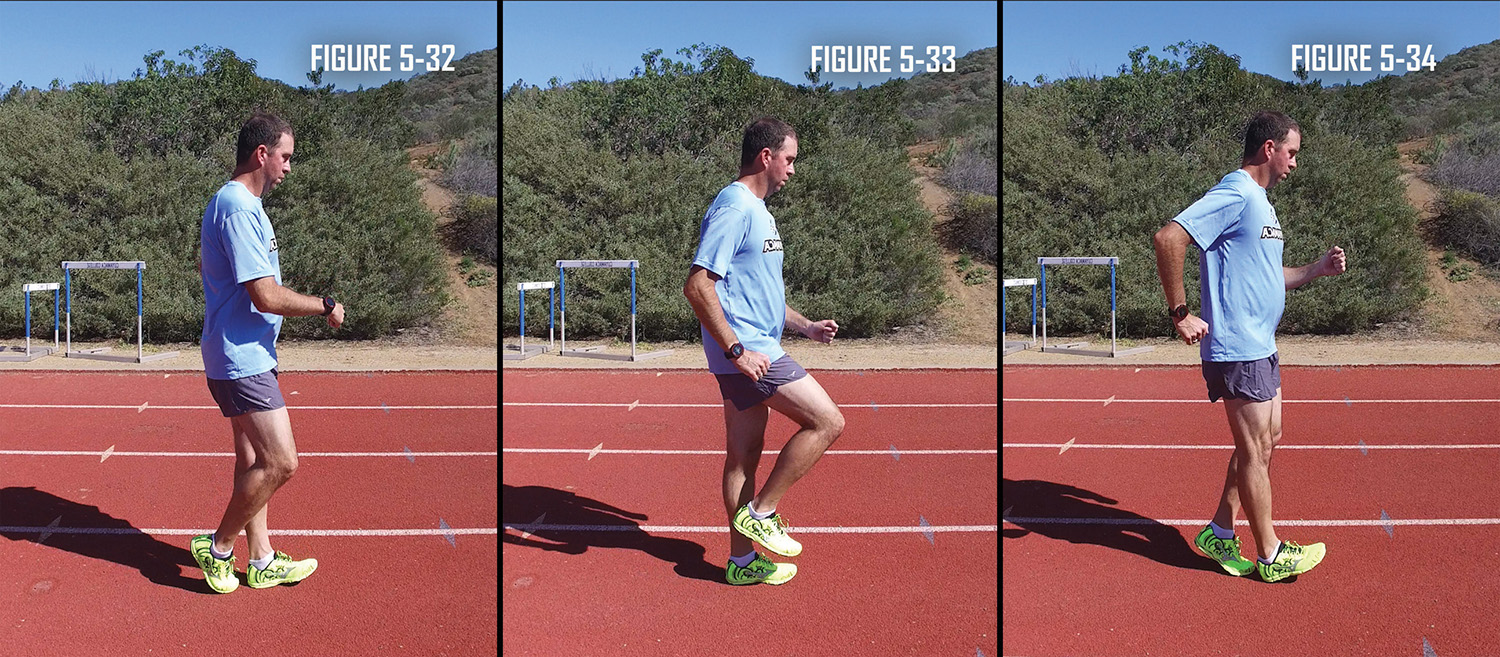

The first 10% of the stride is most important. It’s what helps differentiate a race walker from a speed or health walker. It focuses on heel strike with the toe pointed up. We call it the Foot Plant drill and you must master it before progressing forward.
Body Position
This drill is completed while standing in a race walking like position.
Steps
- Start by standing with your weight on your rear foot (Figure 3-3).
- Swing your other leg forward (Figure 3-4) from the knee until it fully extends.
- As you do, land with your foot slightly in front of the body, with your toes up and the knee straightened (Figure 3-5).
- Transfer all your weight to that leg (Figure 3-6).
- While virtually standing in place, rock back and forth from one foot to the other emphasizing the heel strike.
- Note that the knee does bend when you rock back.
- Repeat this exercise for both legs.


An improvement in forward hip rotation is likely to improve your ability to straighten the knee on impact and keep it straightened until your leg passes the vertical position. When your hips rotate forward, the amount of your stride in front of your torso is reduced, thus reducing the likelihood that your leg bends as you ride forward on it. Therefore, the Long Strides - Long Arms drill and any other drills that target improved forward hip rotation are very useful to avoid bent-knee issues.
Body Position
Perform this exercise while race walking.
Steps
- Keeping both arms straight and your hands flat with your palms back, race walk with an exaggerated stride by driving your hips forward (Figures 5-35 & 5-36).
- Perform this exercise for 30 meters. You should feel a connection between your arms and hips.
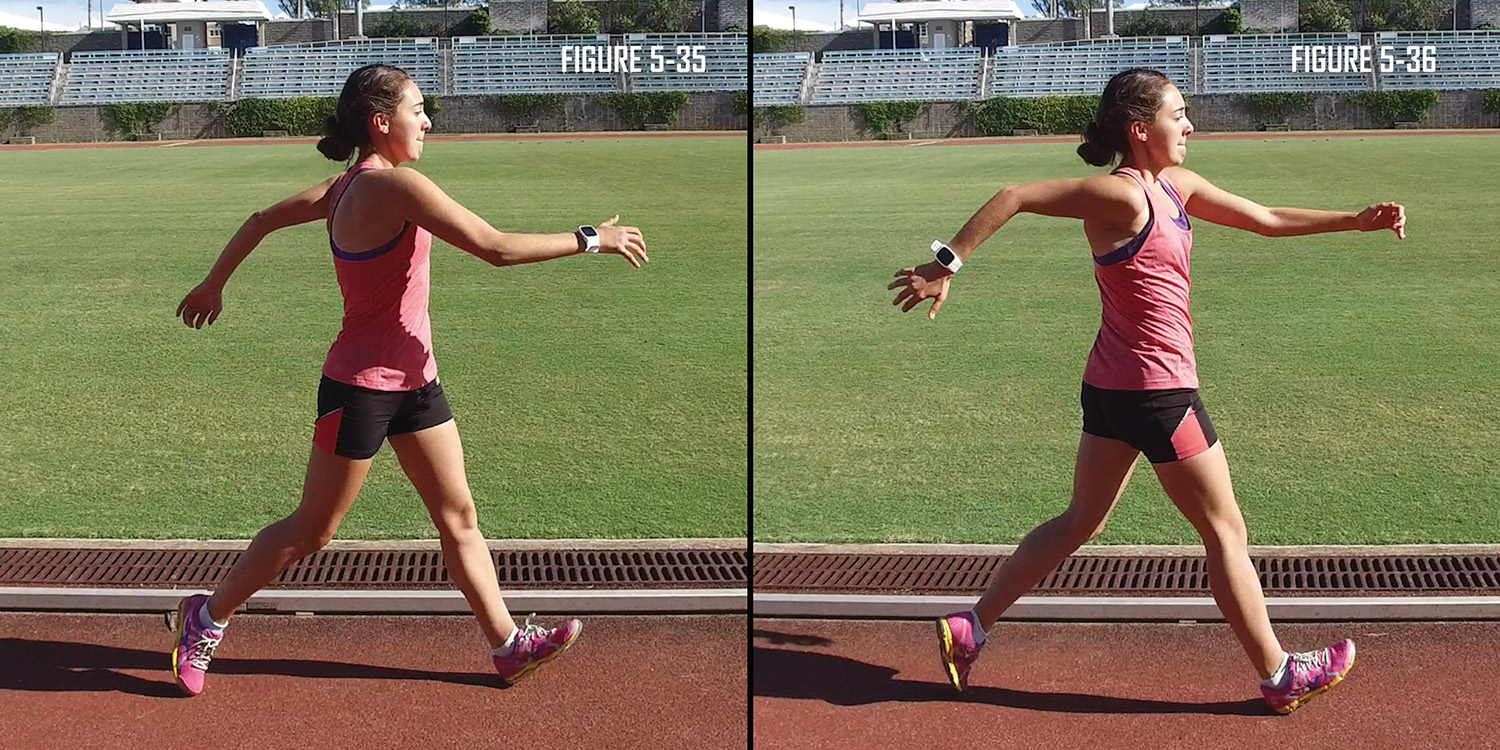

The hamstrings are active during every phase of a race walker’s stride. Sometimes they are eccentrically contracting (tensing the muscle as it lengthens); at other times they are concentrically contracted. Either way, it is imperative that we keep them flexible to maximize their efficiency and ensure that the leg can be straighten properly.
Body Position
Standing straight up.
Steps
- Place one extended leg six inches in front of your body with toes pointed up.
- Bend over slowly and, without bending the knee of your extended leg, reach to touch your toes (Figure 5-37).
- Walk forward, alternating legs and if you are flexible, try reaching beyond your toes (Figures 5-38 & 5-39).
- To relieve the stress on your back, make sure your buttocks is behind your rear foot when touching your toes.
- Perform this exercise for 30 meters.
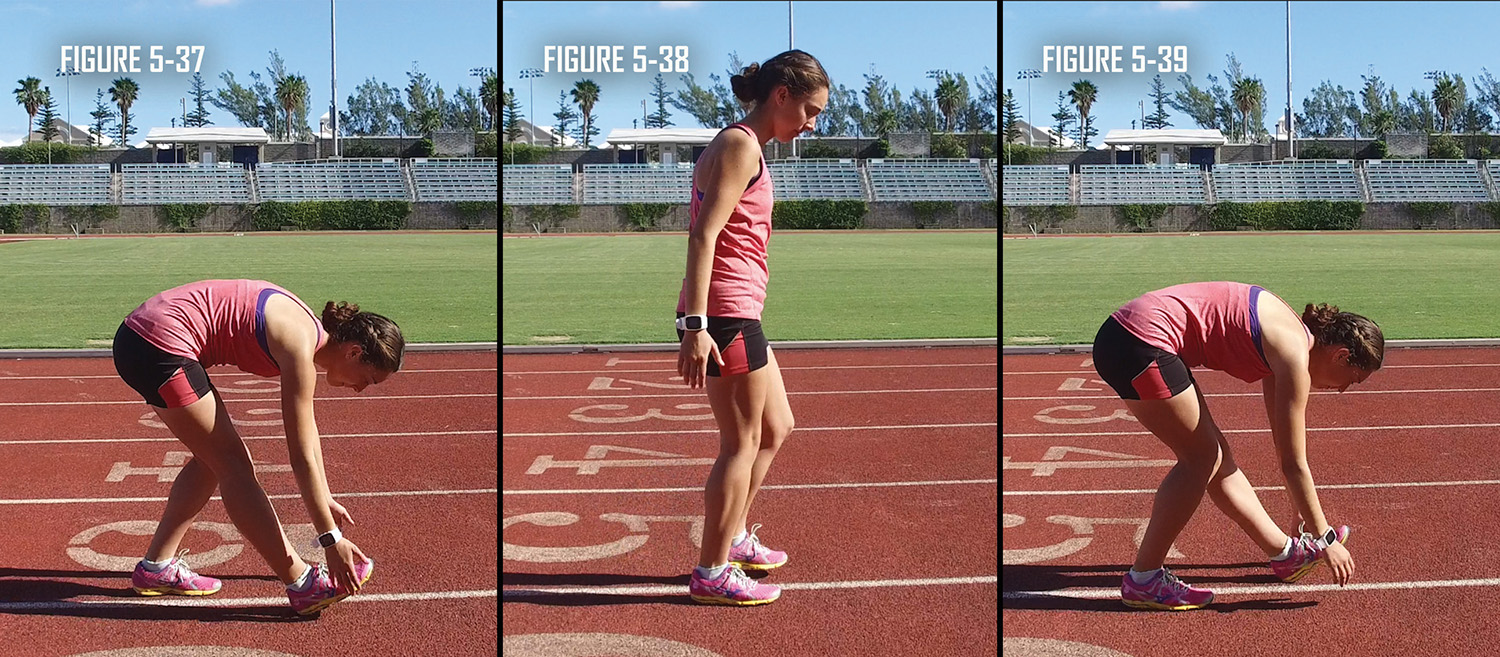

One of the biggest physical causes of bent-knee walking is a lack of adequate shin strength to allow the foot to land with the toe pointed and properly roll through toe off. The single easiest way to strengthen your shins is to walk on your heels.
Body Position
Standing straight up.
Steps
- Walk slowly, with a stride of no more than six inches (Figures 5-40 through 5-42). Remember, it’s not a race.
- Focus on how high you point your toes. The higher you point them, the better and more intensely you work your shins.
- Maintain this technique for 30 meters.
If your shins can’t handle this distance, stop walking on your heels briefly and stretch out your shins (See chapter 5, page 61). Once you have stretched properly, resume heel-walking the remainder of the 30 meters. Upon completion, always stretch out the shins completely. You’ll feel much happier that you did.
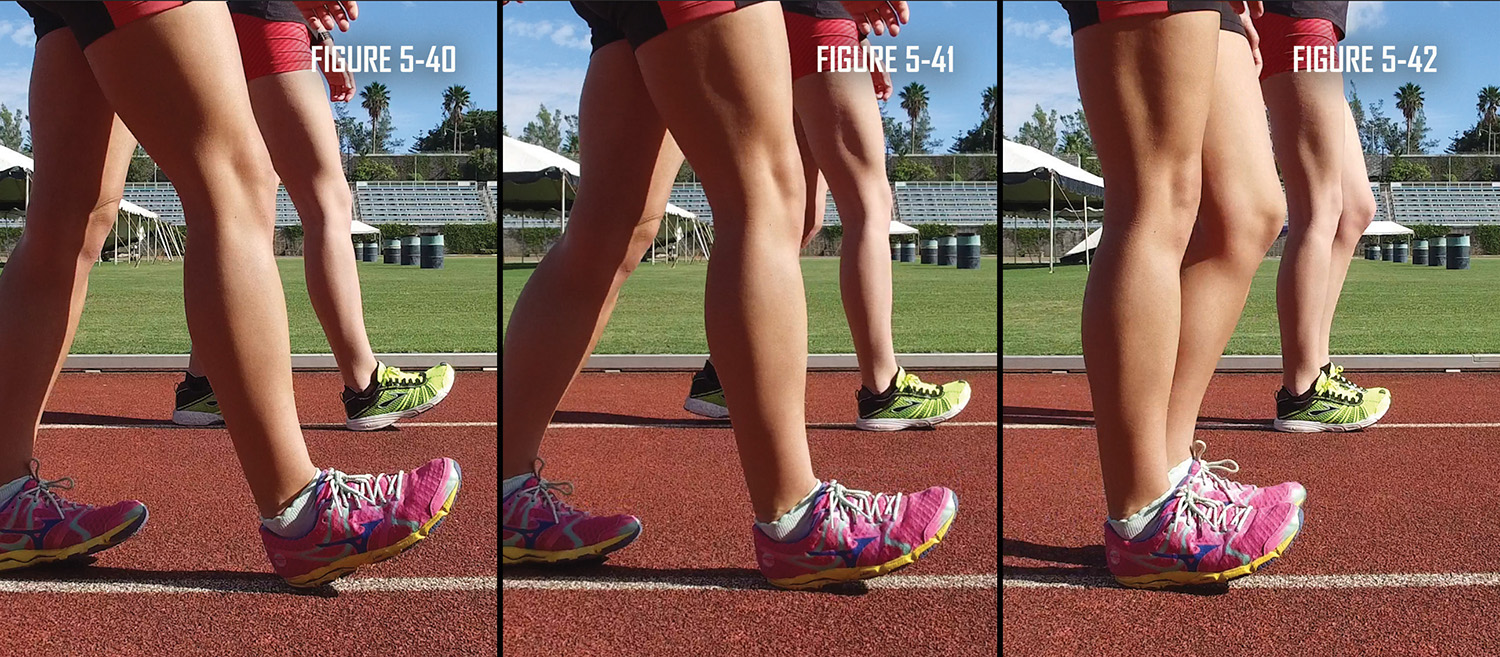

The Toe Raise exercise is another good shin strengthening activity to help you land with your toe pointed and roll through to toe off.
Body Position
Perform this more advanced shin exercise on the edge of a curb or step. Because balance is sometimes difficult when performing this exercise, make sure that you have a pole, wall, or anything to steady yourself. Facing away from the curb/step, place your heels as close to the edge as possible, taking care to remain steady.
Steps
- Pump your toes up and down as quickly as possible while maintaining balance and form (Figures 5-43 through 5-44).
- Focus on getting your toes up high and low. The greater the range of motion your toes pass through, the better the workout. Upon completion, always stretch out the shins.
Please be cautious. The shin muscles are very small and easily irritated. If you overdo this exercise, the shin muscles will become tight and fatigued, making it difficult to race walk properly.
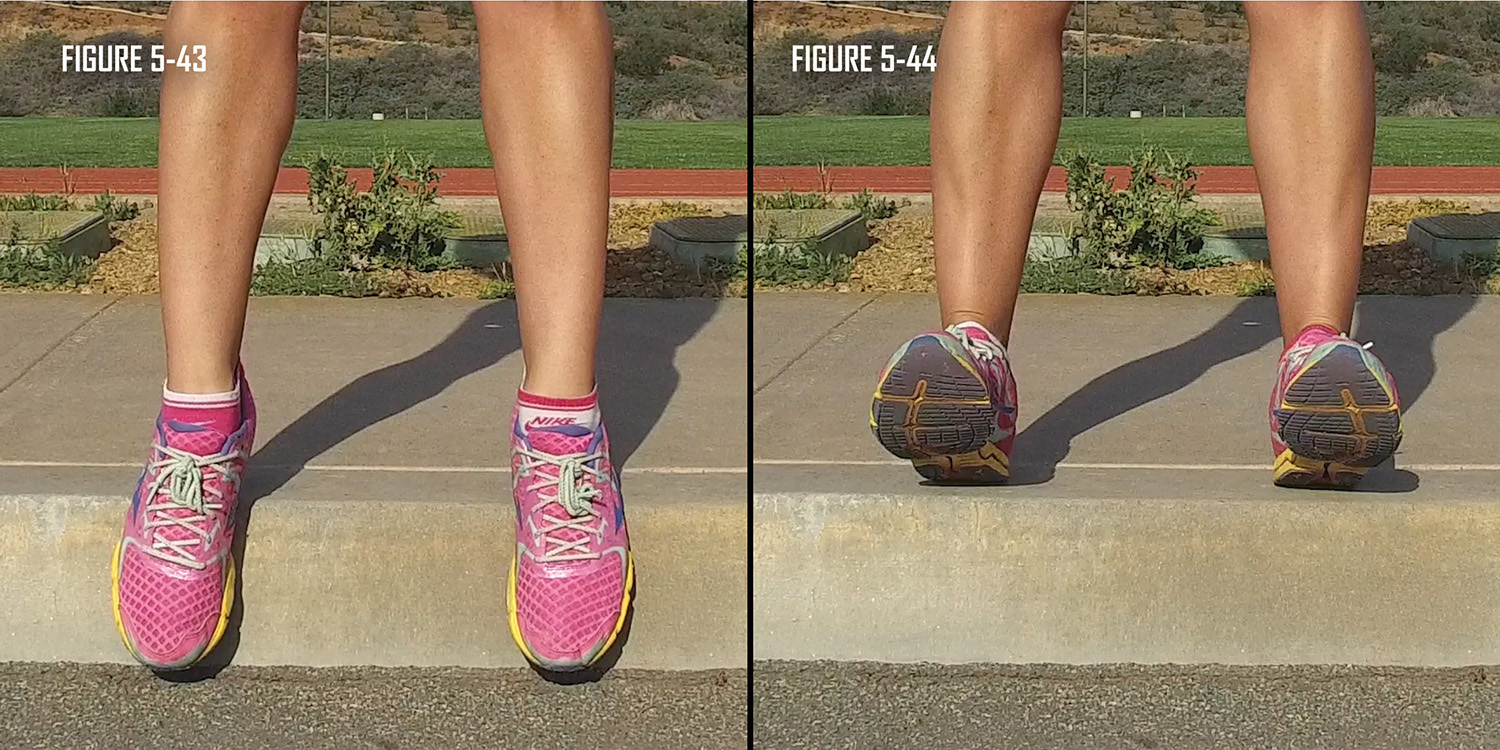

Strengthening muscles involves balance. While athletes often focus on their shins to correct bent-knee walking, they neglect their complementary muscles, the calves. This exercise is similar to the shin strengthening exercise Walk on Your Heels. However, by slowly walking on your toes, you strengthen your calves.
Body Position
Stand with your heels lifted off the ground.
Steps
- Walk slowly, it’s not a race, with a stride of no more than six inches.
- As you walk, focus on keeping your heels as high off the ground as possible (Figures 5-45 through 5-47).
- Walk this way for about 30 meters.
If your calves tire quickly, stop walking on your toes briefly and stretch your calves a bit (see chapter 5, page 57). Then complete the rest of the exercise. If walking 30 meters feels easy, try to go farther. The Calf Raise exercise also strengthens the calf muscles and help balance the shin strengthening exercises. In addition, by doing so, you enable yourself to push off more easily and with greater force.
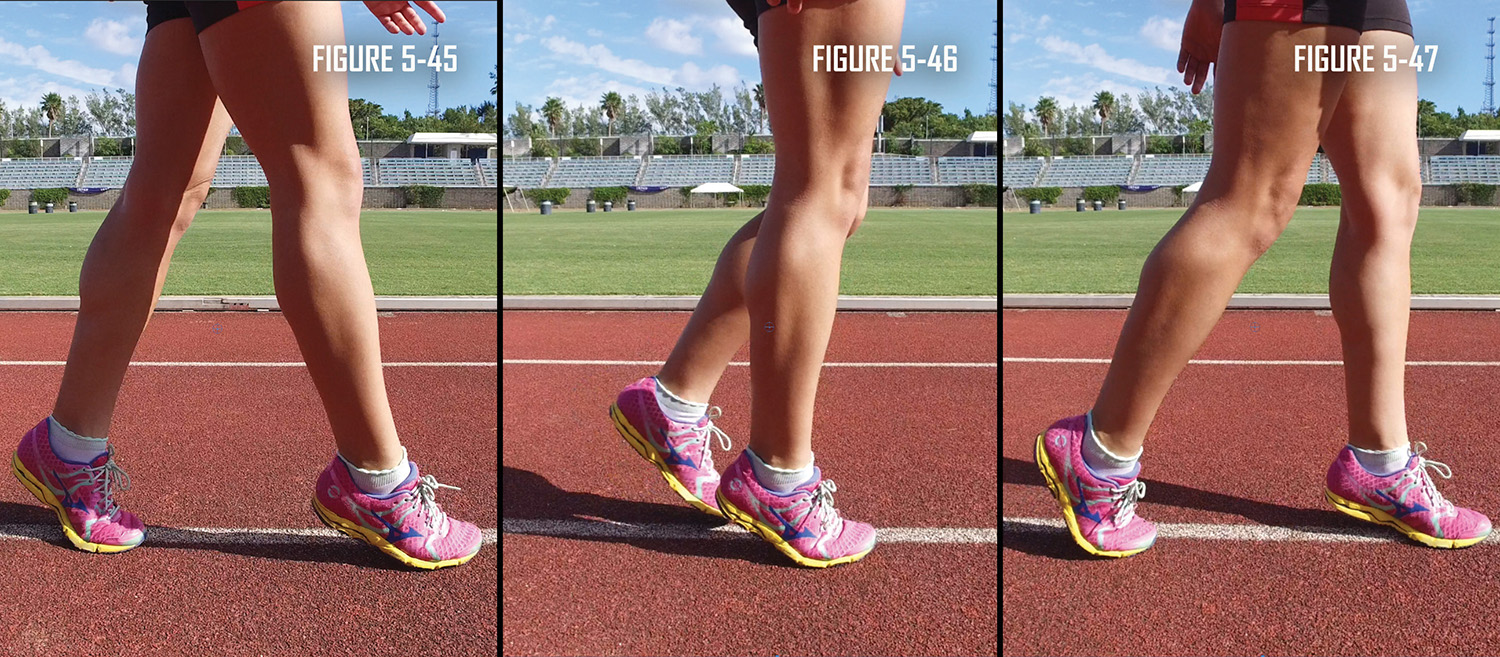

This exercise is best executed with something nearby to help you maintain your balance.
Body Position
Ideally, practice the Calf Raise exercise on a curb near a pole or on a step with a handrail. Find a step or curb and position your toes as close to the edge as possible while still maintaining balance.
Steps
- Place both of your heels beyond the edge, raising and lowering them through a wide range of motion (Figures 5-48 & 5-49).
- Repeat this motion 10 to 15 times, taking care not to cheat by using your upper body for leverage.
- If you are strong enough, try raising and lowering your body on one foot at a time.
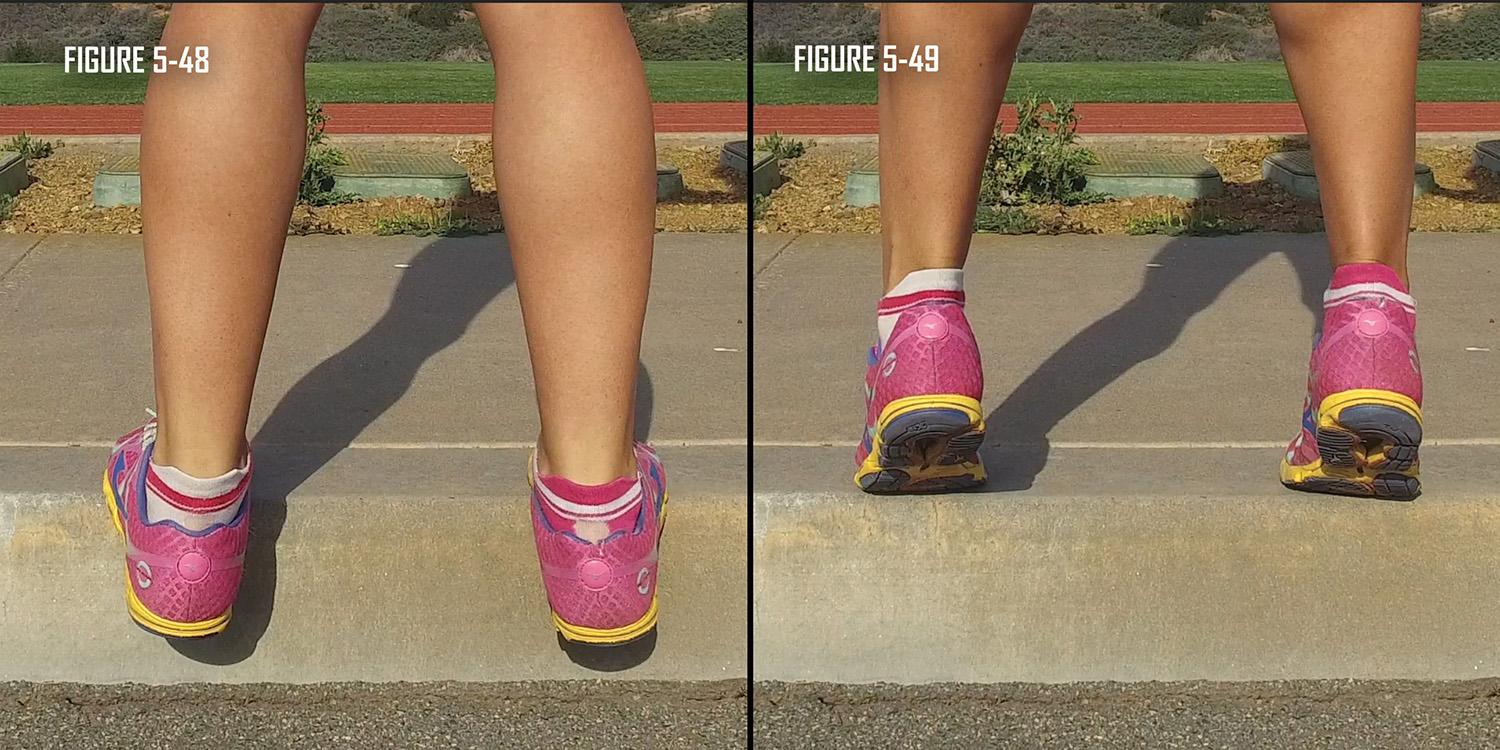

Strong quadriceps are essential for race walking. The quadriceps help the lower leg to swing forward as quickly as possible and are directly responsible for helping to straighten the knee. The goal is to make them strong, but not too big, as large quadriceps hampers our efficiency. Therefore, we want to use low weights and a high number of repetitions to get the muscle in its optimal form for race walking.
Ideally, perform this exercise on a machine, one leg at a time. While machine models differ, most are similar in structure to the one shown. Higher-quality machines usually allow you to adjust the seat and leg roller. Set the equipment so that your knee is on the axis of the machine, with your ankle just below the leg roller.
Steps
- Keeping your shin pressed against the machine, extend your leg nearly to a locked position; exhale as you raise the bar (Figure 5-50).
- While inhaling, lower your leg to its original position (Figure 5-51).
- Repeat this exercise 20 times with each leg for 2-3 sets. As you execute the exercise, make sure that your ankle remains in contact with the roller and that you are controlling the weight.
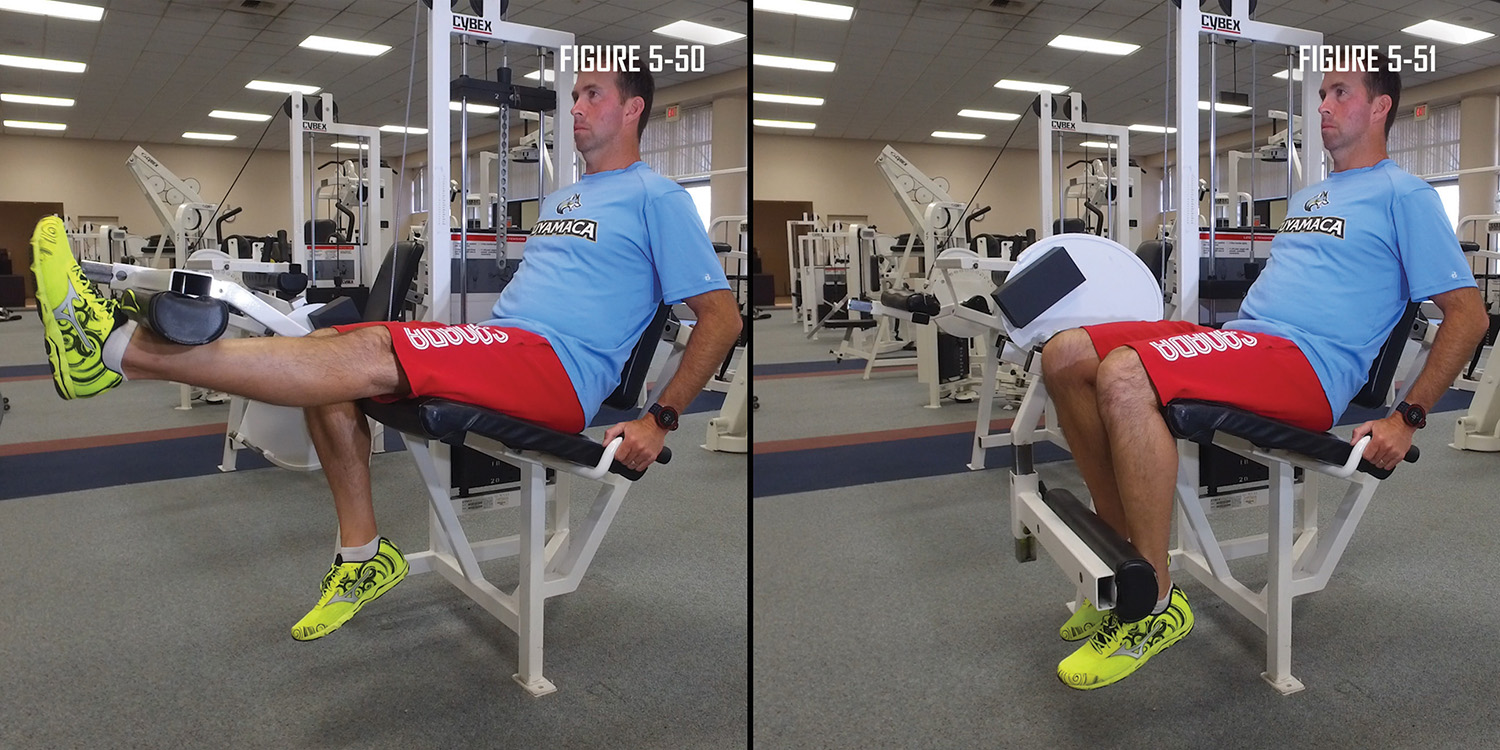

We know quadriceps strength is important, but some of us may not have a leg extension machine accessible. Here’s a low-tech way to achieve the same results.
Body Position
Sit in a tall stool or chair and strap a light ankle weight around your ankle; beginners may choose to skip the weight (Figure 5-52).
Steps
- Straighten the leg with the ankle weight (Figure 5-53).
- While exhaling, lower the leg to the original position (Figure 5-52).
- Repeat 15 times and then switch legs.
- Repeat for 3 sets.


Strong hamstrings are important to race walking. The hamstrings are active during every phase of a race walker’s stride. Sometimes they are eccentrically contracting; at other times they are concentrically contracted (tensing the muscle as it shortens). Either way, it is imperative that we keep them strong to maximize their efficiency and our legality.
Body Position
This exercise is best performed on a machine, one leg at a time. With few exceptions, most machines are similar in structure to the one shown. Higher-quality equipment usually allows you to adjust the platform and leg roller; set them so that you situate your knee on the axis of the machine, with the ankle just below the leg roller (Figure 5-54).
Steps
- While exhaling and keeping your thigh pressed against the machine, curl your leg, pulling your heels inward so that the leg roller approaches your buttocks (Figure 5-55).
- While inhaling, complete the exercise by lowering your leg back to its original position (Figure 5-54).
- Always maintain contact between the roller and your leg as you execute the lift. Also pay attention to maintain control of the weight throughout the exercise.
- Repeat 20 times with each leg and complete 3 sets.
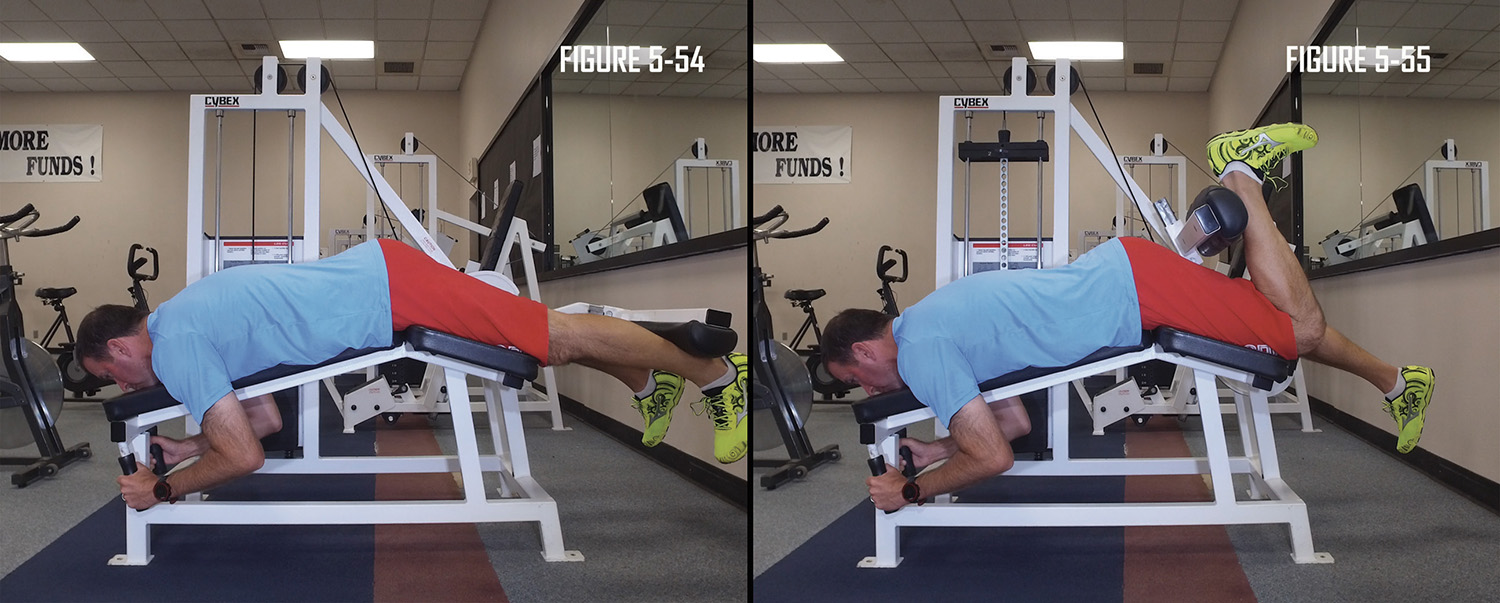

We know hamstring strength is important, but some of us may not have a leg curl machine accessible. Here’s a low-tech way to achieve the same results using an ankle weight to simulate the machine.
Body Position
Either stand next to a wall / pole for balance or perform this exercise laying on a bench. Strap a light ankle weight around your ankle; beginners may choose to skip the weight (Figure 5-56).
Steps
- Raise the leg with the ankle weight, while inhaling, until your lower leg is parallel with the floor. Support yourself with the opposite leg (Figure 5-57).
- Hold for one second.
- Lower the leg, while exhaling, to the original position (Figure 5-56).
- Repeat 20 times and then switch legs.
- Repeat for 3 sets.
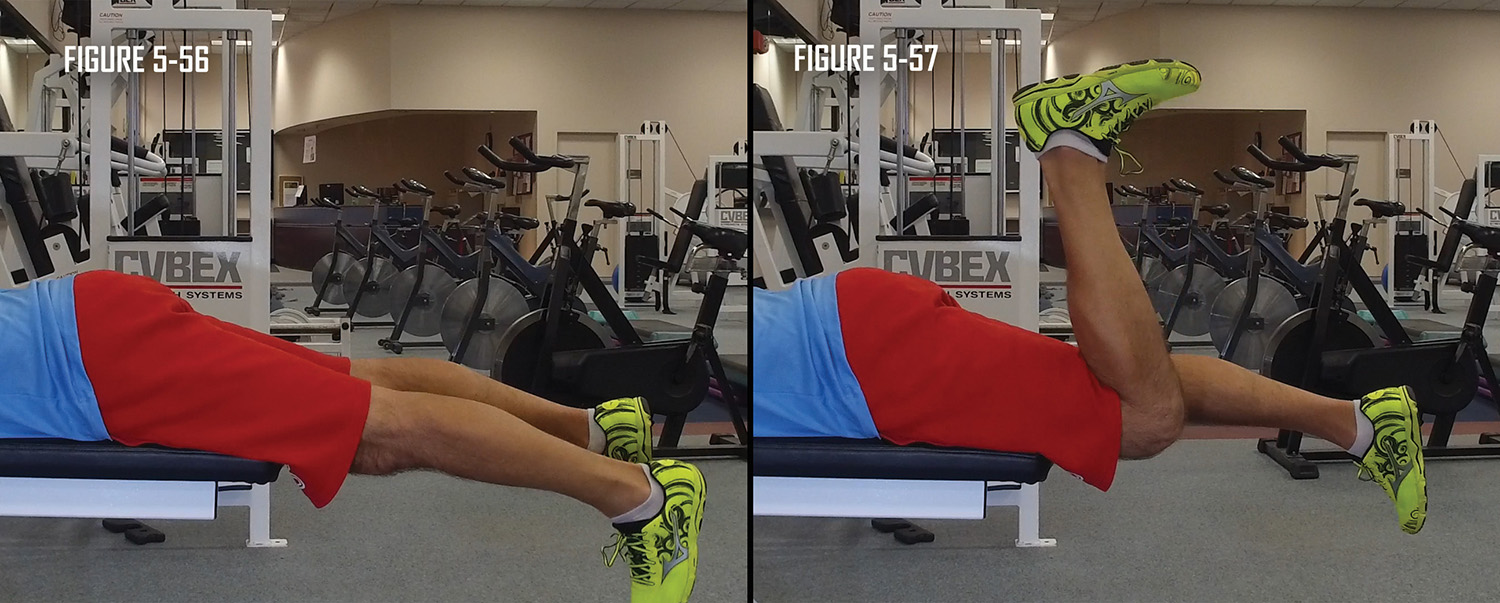
Next Lesson: Stretches to Correct Bent Knee Walking